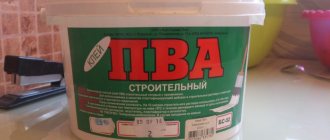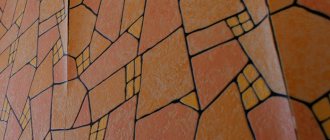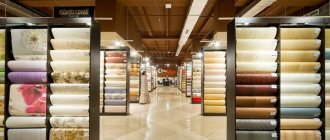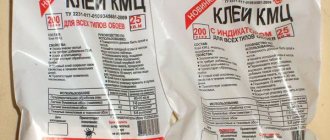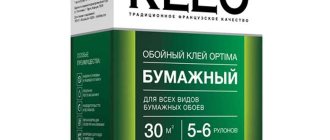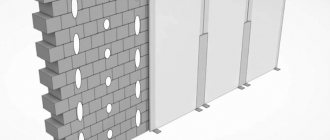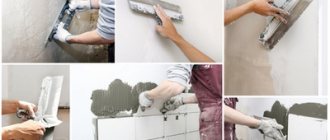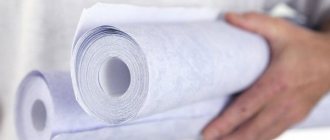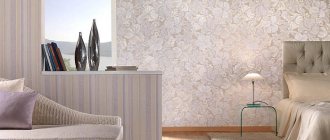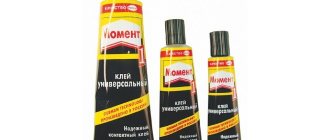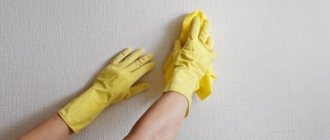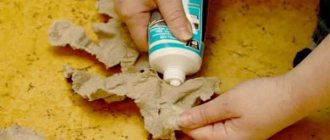Wallpaper glue is most often purchased at the same time as wallpaper rolls. Knowing the type of main surface and the characteristics of the wallpaper, choosing the optimal (suitable) adhesive composition is not particularly difficult. In addition, professional construction markets have competent consultants who can clearly clarify unclear points and advise something specific.
The right choice is an important matter, but the ability to use it correctly is also a significant factor. This article is devoted to the issue of using wallpaper glue.
Wallpaper glue consumption
Most companies put information on the approximate consumption of the adhesive composition on the packaging of their products, however, such data does not correspond to reality. The point is the uniqueness of each case of using the material. Certain conditions can significantly increase or decrease the quantitative consumption of the adhesive mass, so there may be some discrepancies with the consumption stated in the instructions.
The type of wallpaper is an important point that requires special attention before starting to dilute the material with warm water. The denser the structure and weight of the wallpaper, the thicker the adhesive mass should be.
A little trick! In this situation, it is possible to reduce the working consumption of the fixing agent, provided that the wall surface is properly prepared. You can roughly reduce costs by a third like this:
— use of a two-layer primer treatment instead of a single application;
— use of all materials from one manufacturer!
The structure of the main surface is the characteristics of the material on which the wallpaper is applied (concrete, wood, drywall, etc.). This in some cases seriously affects the consumption of the adhesive mass. For example, rough and porous surfaces require a larger volume of fixative, unlike dense and smooth counterparts.
Some useful tips
- Always read the manufacturer's instructions on the packaging before starting work. Because Russian people usually grab the instructions when they understand that something has gone wrong.
- The exact proportions of the amount of water and glue are deliberately not given here. Because they vary significantly for each company. The only recommendation: always take 0.5 liters less water than what is written in the instructions. It is better to add this amount later if the mixture seems thick to you. Because liquid glue can no longer thicken.
- Do not pour the entire dry mixture into the water in one fell swoop. You will get a dense lump, which will be difficult to stir later. And lumps of finished glue can leave unsightly swellings or small bubbles under non-woven wallpaper.
- By the way, non-woven wallpaper sticks better with thick glue. If used correctly, it will then be difficult to find the joints of the sheets yourself.
- If your joints peel off after drying, we recommend purchasing a special pencil for gluing. It provides a thin but strong adhesive layer. And the thickness of the rod makes it convenient to use at joints. In addition, it does not leave streaks or other marks on the dark picture.
- Some sources recommend adding PVA glue to the finished mixture. They say the wallpaper lasts better this way. We really don't recommend doing this. If you follow all the instructions, the wallpaper will hold up well even without PVA. And during the next renovation, there is a high probability of removing the old wallpaper along with pieces of the walls. After all, PVA has very good adhesion.
- Do not cook glue for non-woven wallpaper the old fashioned way, from starch or flour. This is the last century. Such a mess can easily hold ordinary paper wallpaper on the wall. But non-woven ones will remarkably fall off in whole layers within a week. At the same time, you will no longer be able to reattach them to normal industrial glue. Because the paste disrupts the structure of the non-woven fabric. Don't create problems and headaches for yourself. If your budget includes the amount for good wallpaper, then allocate funds for the right glue. It's not that expensive.
How to dilute glue for non-woven wallpaper? Now you definitely know all the technology. And in any situation you can easily and effortlessly apply the required amount of glue to the required consistency. Happy renovation!
https://howtogetrid.ru/kak-razvesti-klej-dlya-flizelinovyx-oboev/
Let's analyze the most likely glue consumption (in relation to vinyl wallpaper):
1. When the surface requires preliminary priming, the mixture (dry) is diluted with heated water in a ratio of 1:40. This proportion is obtained by dissolving a standard pack (300.0 g) of the substance in a container with 12.0 liters of water. The resulting amount of glue is enough for a full primer of approximately 100.0 square meters. m of concrete-brick walls.
2. To apply structural, textile or vinyl wallpaper, a fairly thick adhesive mass is required. Dry fixative powder (300.0 g) must be thoroughly diluted with heated water (6.0 l) - proportion 1:20. The prepared amount of mixture will be sufficient to thoroughly process approximately 36.5–40.3 square meters. m.
3. Thin, light wallpaper can be glued with a less dense glue. You can dilute a 300.0 gram package with 9.0 liters of water in a ratio of 1:30. The resulting volume, if applied correctly, will cover 45.5–50.3 square meters. m of working surface.
Differences between Moment and other manufacturers
For surface finishing, a specialized “Moment” is made, which is used to work with certain types of wallpaper. During production, the components included in the composition are mixed in proportions, forming specially targeted mixtures.
The cardboard packaging of Moment products contains information: the method of preparing the working mixture, the shelf life of the dry powder and the number of components included in the wallpaper paste.
“Moment” includes several types:
- Extra. Made for canvases with a complex base - textured, heavy and others. Provides high adhesive properties of the surface being glued.
- For joints. In case of divergence of joints during use, gluing is carried out with a special solution, which helps to cope with the problem faster and with better quality.
- Specialized formulations with a narrow focus. This category includes “Vinyl”, “Non-woven” and “Classic”. From the first two names it is obvious what wallpaper base they are intended for. “Classic” is used for installing traditional type wallpaper - paper.
The main component contained in “Moment” is modified starch. The solution contains ingredients that prevent the spread and formation of mold. This advantage is appreciated when gluing fabrics with an artificial base - vinyl or non-woven fabric.
Preparing the main surface
First of all, the wall surface must be carefully prepared. The designated scope of work consists of a set of actions.
1. Cleaning (removing) the old coating to a solid base (plaster, brick, concrete, etc.). The wallpaper to be removed must be thoroughly soaked with clean water and scraped off with a spatula. The tiles are usually knocked off and the paint is removed using a suitable active solvent.
2. Leveling the surface - carefully sealing cracks, crevices and other defects with paste plaster, and protruding parts are removed with a hammer or compact chipper. After the completed manipulations, rough polishing is performed with sandpaper. Then the surface is cleaned of all contaminants, leveled with putty and sanded again with fine sandpaper (P140–P170).
Preparatory work before gluing
Returning directly to the gluing process, you will have to start removing the old wall material:
Wallpaper. To get rid of them easily, you will have to soften them first. To do this, you can wet it with soapy water and add a little wallpaper glue. This component will make it possible to hold the solution on the wall, which means the paper will easily get wet. If the old wallpaper is made of dense material or is washable, then it is worth scratching it so that the solution seeps in to the base.
When the paper web gets wet, remove it with a metal spatula. If the wallpaper cannot be removed, you can repeat.
A layer of paint. The wall will have to be cleaned, despite the fact that this is not a quick task, because wallpaper glued to such a surface will disappear very quickly
For this purpose, special washes are suitable, which are used with some precautions, wearing a respirator, safety glasses and gloves while working. You can also use a drill with a brush attachment.
After the walls have been cleared of old wall material, they proceed to sealing defects such as cracks and unevenness using putty. Then you should prime the walls: buy a dry adhesive mixture for vinyl wallpaper, which is diluted with water, following the instructions, or a deep penetration primer. The thickness of the primer that is applied to the wall is up to 6 mm.
Since the wallpaper is not only waterproof, but also airtight, a fungicidal composition is applied to the surface of the walls. It will protect the surface under the wallpaper from mold. After these procedures, you need to dry the walls. To check dryness, glue a piece of polyethylene with masking tape. If droplets of water form on the inside, it means the surface has not yet dried. When the composition and the walls are dry, take a plumb line (thread with a weight) and fill a vertical line, which is used as a guide for gluing the first sheet of wallpaper.
Preparing the canvas for gluing
It is very important, when starting to hang wallpaper, to check the purchased rolls for the same pattern, color, and batch number. Check the length of the roll to find out the number of stripes per roll, since there can be either 10 or 20 meter vinyl wallpaper
The total number of stripes will depend on the perimeter of the room. After this, they begin cutting. Of course, the version of the canvas without patterns is the easiest. In this case, the length of the strips is the same, which means they are simply unwound from the roll and cut off.
An option, when there is a more complex pattern, is to ensure its alignment during direct joining. If you select a pattern with an offset, you will have to shift the subsequent canvas. Therefore, when buying wallpaper with a pattern, you need to take into account the allowance for selecting the pattern. The strips are unrolled from the wallpaper roll in one direction. To cut the wallpaper into strips of the required length, be sure to leave a 10 cm allowance on each strip. It is better to cut with a stationery knife. If the wallpaper has a pattern, mark the top of each strip with a pencil so that you can paste it correctly in the future.
How to dilute wallpaper glue?
Dilute wallpaper glue with purified water, following the instructions in the instructions supplied with the substance.
The sequence of actions is most often as follows:
— the required volume of water is poured into a deep container (plastic or enamel);
Attention! If you use cold water, the time for stirring and cooking the glue will double. When heated water is used for dissolution, the powder concentrate dissolves almost instantly, but there is a risk of the formation of lumps and clots. The latter option will require constant monitoring and continuous stirring of the mixture until it is completely cooked!
- pouring dehydrated (dehydrated) glue granules in small portions into a container with water. The solution must be thoroughly mixed.
It is most convenient to carry out high-quality stirring with a construction mixer or a drill with a mixer attachment at a slow speed setting. When there are no similar tools, the prepared mass can be easily stirred with a suitable stick or, for example, a plastic tube;
Advice! It is very convenient to prepare the adhesive mass in pairs with an assistant - someone pours the granulated powder, and the second continuously mixes the composition!
— keep the glue for 14–17 minutes until the thick solution is homogenized;
- final mixing of the mass, after which it will be completely ready for the start of finishing work.
General rules
Finishing specialists recommend purchasing glue and non-woven wallpaper of the same brand. The manufacturer accurately selects the necessary components in the best variation. If the store does not have the same brand, then purchase glue from the most famous companies. Then you definitely won’t have any unpleasant surprises in the form of too liquid a solution or, conversely, a cement mass with lumps.
If you wish, you can consult with the seller. As a rule, they always give a comprehensive answer on all types of non-woven wallpaper and adhesives for them. Only when the seller recommends buying universal glue can you safely judge his incompetence. Because this type of glue can only hold thin paper wallpaper. And even then, on a carefully prepared wall.
We recommend purchasing glue for non-woven wallpaper immediately with a reserve. Firstly, for preliminary priming of walls. This makes joining seams much easier. Secondly, diluted glue can be safely stored for a whole week at room temperature, and dry glue can be stored until the expiration date. Therefore, let it be. Thirdly, if dilution fails, you won’t have to go shopping to find glue of the same brand. Or there won’t be enough liter mug to finish gluing the last piece of non-woven wallpaper - you’ll also have to run out and buy it.
Advice. All tools and containers must be absolutely clean, without a trace of other solutions. There is nothing worse when, trying to smooth out the wallpaper on the wall, people tore off thin strips of non-woven material with pieces of dried cement mortar or grains of sand that got into the adhesive mixture.
